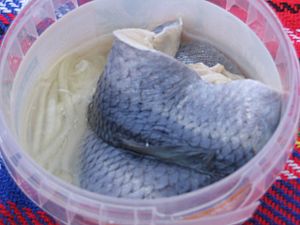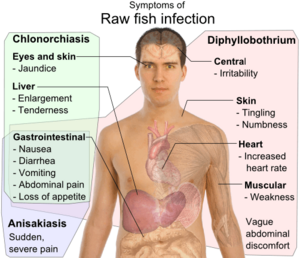List of raw fish dishes facts for kids
Raw fish dishes are foods made from fish or shellfish that haven't been cooked with heat. This can include fish that's been soaked in a flavorful liquid (marinated) or lightly preserved, like gravlax. However, it doesn't include fish that's fully preserved by fermenting, pickling, or smoking.
Popular Raw Fish Dishes
| Name | Image | Origin | Description |
|---|---|---|---|
| Aguachile | Mexico | Raw shrimp soaked in lime juice with cucumber, onion, and spicy chiltepín peppers. | |
| Carpaccio |  |
Italy | Very thin slices of marinated swordfish, tuna, or other large fish. This is a fish version of a dish usually made with beef. |
| Ceviche |  |
Perú | A popular dish of raw fish marinated in citrus juices, often lime or lemon. |
| Crudo |  |
Italy | Raw fish slices dressed with olive oil, sea salt, and citrus juice. |
| E'ia Ota | Tahiti | Raw tuna mixed with lime juice and creamy coconut milk. | |
| Esqueixada |  |
Catalan | A salad made with raw cod, fresh tomatoes, and black olives. |
| Gravlax |  |
Nordic | Raw salmon lightly cured with salt, sugar, and dill. It's often served thinly sliced as a starter. Fishermen in the Middle Ages used to bury salmon in sand to preserve it. Today, it's cured in a dry mix for a few days instead of being fermented. |
| Gohu Ikan | Maluku, Indonesia | This dish can be made with tuna, skipjack, or grouper. The fish is cleaned and marinated with salt and citrus juice. It's then mixed with sliced onion, spicy chili, and basil leaves. It tastes sour and spicy, with a strong basil smell. | |
| Hinava |  |
Malaysia | A traditional dish from the Kadazan-Dusun in Sabah. It uses raw white fish marinated in citrus juice (like calamansi lime). It also includes sliced shallots, ginger, and grated dried bambangan fruit. |
| Hoe |  |
Korea | Slices of raw seafood, usually eaten with soy sauce or a spicy pepper paste. |
| Kelaguen | Mariana Islands | A Chamorro dish similar to the Filipino kinilaw. While often made with cooked meat, it can also use raw fish and other seafood. | |
| Kinilaw |  |
Philippines | A traditional marinated dish, usually with raw fish. It's soaked in local vinegars or sour fruits like calamansi. Some versions add coconut milk to balance the flavors. |
| Koi pla | 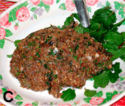 |
Thailand | Minced or finely chopped raw fish in a spicy salad. This is a very popular raw fish dish in Isan. |
| Kokoda |  |
Fiji | An appetizer or side dish made from white fish. It's a common food in Fiji. |
| Kuai | China | Thin strips of raw fish or meat, popular in ancient China. The Book of Rites describes how to prepare these thin slices. In modern times, it's called "raw fish slices." Fish like carp and salmon are used. Sauces were always important with kuai. | |
| Lakerda | Turkey | A pickled bonito dish, eaten as a small appetizer (mezze). The best lakerda is made from young bonito fish from the Bosphorus. | |
| Lap pa Larb pla |
Laos Thailand |
A Lao and Thai salad made with raw freshwater fish. It's mixed with lime, cilantro, mint, scallions, roasted rice, and chilis. | |
| Lawa' Bale | South Sulawesi, Indonesia | A dish often linked to the Bugis people. It features fresh raw fish cured in vinegar and citrus juices, like bilimbi and unripe mango. It's spiced with grated coconut, garlic, and chilies. | |
| Lomi oio | 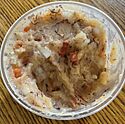 |
Hawaii | Finely chopped or mashed raw fish mixed with salt. Sometimes seaweed, onions, or tomatoes are added. |
| Namerō | 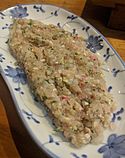 |
Japan, Bōsō Peninsula | Finely chopped raw fish mixed with spices and spread thinly. |
| 'Ota 'ika |  |
Tonga | A raw fish dish typically made with coconut cream, tomatoes, lemon, and spring onions. |
| Poke | 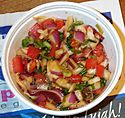 |
Hawaii | A popular raw fish salad. |
| Sashimi |  |
Japan | Thinly sliced raw seafood. It's usually dipped in soy sauce and wasabi before eating. |
| Soused herring (maatjes) |  |
Netherlands | Fresh herring from the new season, soaked in a mild preserving liquid. |
| Stroganina |  |
Russia | A dish from the indigenous people of northern Arctic Siberia. It's made from very thin slices of frozen raw fish. |
| Tiradito | 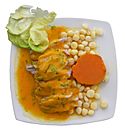 |
Peru | A type of ceviche that shows the influence of sashimi. |
| Tuna tartare |  |
Disputed | A dish made from finely minced raw tuna. |
| Umai | Malaysia | A dish very similar to hinava, popular with the Melanau community in Sarawak. | |
| Xató or Xatonada |  |
Catalan | Raw cod, anchovies, and tuna fish with escarole lettuce, arbequina olives, and "romesco" sauce. |
| Yusheng |  |
Disputed | A raw fish salad. |
Staying Safe: Health Concerns with Raw Fish
It's natural for fish to have tiny living things called parasites. These are usually not a problem if fish is cooked well. However, when you eat raw or lightly preserved fish like sashimi or ceviche, parasites can be a concern. Because raw fish dishes are so popular, it's good to know about this risk.
To kill parasites, raw fish should be frozen. It needs to be at a very cold temperature, like -20 °C (-4 °F), for at least 7 days. It's important to know that regular home freezers might not get cold enough to kill all parasites.
Historically, fish that live in fresh water were not used for sashimi. This was because they were more likely to carry parasites. Parasite infections from freshwater fish are a serious issue in some parts of the world, especially Southeast Asia. Fish like salmon, which spend part of their lives in both fresh and salty water, can also be a concern. One study in Seattle, Washington found that all wild salmon had a type of roundworm larvae that could infect people. However, salmon raised on farms in the same study did not have these larvae.
Getting a parasite infection from raw fish is quite rare in many developed countries. When it does happen, it's usually from one of three main types of parasites. These infections can often be avoided by cooking fish thoroughly, preserving it in salt or vinegar, or freezing it overnight. In Japan, people often eat raw salmon and salmon roe (ikura). But these foods are usually frozen overnight before being eaten to prevent parasite infections.
More to Explore


